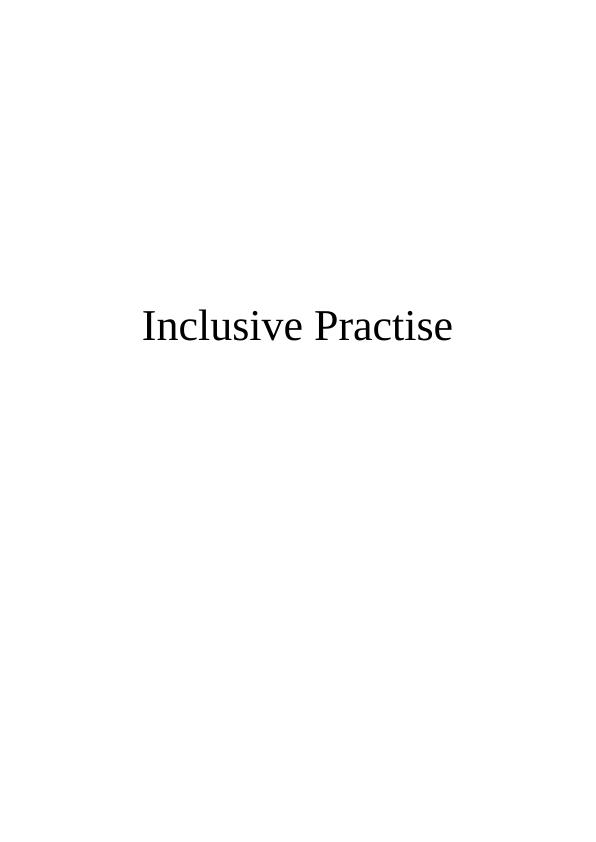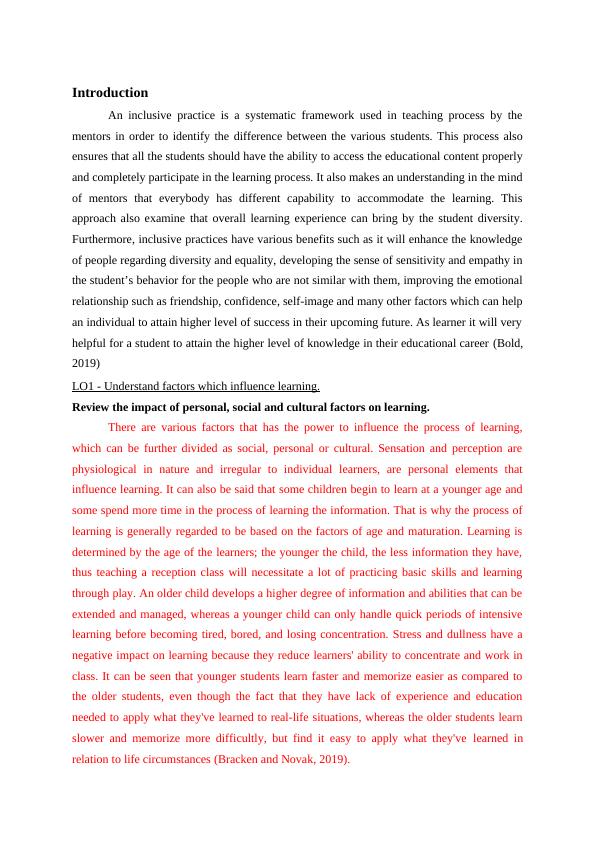Inclusive Practice (Pass Criteria)
Added on 2023-06-10
10 Pages3425 Words343 Views
Inclusive Practise

Contents
Introduction................................................................................................................................3
LO1 - Understand factors which influence learning..............................................................3
LO2- Understand the impact of policy and regulatory frameworks on inclusive practice....4
LO3 Understand roles and responsibilities relating to inclusive practice..............................6
LO3.1 Summarise own role and responsibilities relating to inclusive practice.....................6
LO3.2 Explain the relationship between own role and the roles of other professionals
involved in inclusive practice.................................................................................................6
LO4 Understand how to create and maintain an inclusive learning environment.................6
LO4.1 Review key features and benefits of an inclusive learning environment...................6
LO4.2 Analyse ways to promote equality and value diversity..............................................7
LO4.3 Analyse ways to promote inclusion............................................................................7
LO4.4 Review strategies for effective liaison between professionals involved in inclusive
practice...................................................................................................................................7
LO5 Understand roles and responsibilities relating to inclusive practice..............................7
LO5.1 Review the effectiveness of own inclusive practice...................................................7
LO5.2 Identify own strengths and areas for improvement in relation to inclusive practice. .8
LO5.3 Plan opportunities to improve own skills in inclusive practice..................................8
Conclusion..................................................................................................................................8
References................................................................................................................................10
Introduction................................................................................................................................3
LO1 - Understand factors which influence learning..............................................................3
LO2- Understand the impact of policy and regulatory frameworks on inclusive practice....4
LO3 Understand roles and responsibilities relating to inclusive practice..............................6
LO3.1 Summarise own role and responsibilities relating to inclusive practice.....................6
LO3.2 Explain the relationship between own role and the roles of other professionals
involved in inclusive practice.................................................................................................6
LO4 Understand how to create and maintain an inclusive learning environment.................6
LO4.1 Review key features and benefits of an inclusive learning environment...................6
LO4.2 Analyse ways to promote equality and value diversity..............................................7
LO4.3 Analyse ways to promote inclusion............................................................................7
LO4.4 Review strategies for effective liaison between professionals involved in inclusive
practice...................................................................................................................................7
LO5 Understand roles and responsibilities relating to inclusive practice..............................7
LO5.1 Review the effectiveness of own inclusive practice...................................................7
LO5.2 Identify own strengths and areas for improvement in relation to inclusive practice. .8
LO5.3 Plan opportunities to improve own skills in inclusive practice..................................8
Conclusion..................................................................................................................................8
References................................................................................................................................10

Introduction
An inclusive practice is a systematic framework used in teaching process by the
mentors in order to identify the difference between the various students. This process also
ensures that all the students should have the ability to access the educational content properly
and completely participate in the learning process. It also makes an understanding in the mind
of mentors that everybody has different capability to accommodate the learning. This
approach also examine that overall learning experience can bring by the student diversity.
Furthermore, inclusive practices have various benefits such as it will enhance the knowledge
of people regarding diversity and equality, developing the sense of sensitivity and empathy in
the student’s behavior for the people who are not similar with them, improving the emotional
relationship such as friendship, confidence, self-image and many other factors which can help
an individual to attain higher level of success in their upcoming future. As learner it will very
helpful for a student to attain the higher level of knowledge in their educational career (Bold,
2019)
LO1 - Understand factors which influence learning.
Review the impact of personal, social and cultural factors on learning.
There are various factors that has the power to influence the process of learning,
which can be further divided as social, personal or cultural. Sensation and perception are
physiological in nature and irregular to individual learners, are personal elements that
influence learning. It can also be said that some children begin to learn at a younger age and
some spend more time in the process of learning the information. That is why the process of
learning is generally regarded to be based on the factors of age and maturation. Learning is
determined by the age of the learners; the younger the child, the less information they have,
thus teaching a reception class will necessitate a lot of practicing basic skills and learning
through play. An older child develops a higher degree of information and abilities that can be
extended and managed, whereas a younger child can only handle quick periods of intensive
learning before becoming tired, bored, and losing concentration. Stress and dullness have a
negative impact on learning because they reduce learners' ability to concentrate and work in
class. It can be seen that younger students learn faster and memorize easier as compared to
the older students, even though the fact that they have lack of experience and education
needed to apply what they've learned to real-life situations, whereas the older students learn
slower and memorize more difficultly, but find it easy to apply what they've learned in
relation to life circumstances (Bracken and Novak, 2019).
An inclusive practice is a systematic framework used in teaching process by the
mentors in order to identify the difference between the various students. This process also
ensures that all the students should have the ability to access the educational content properly
and completely participate in the learning process. It also makes an understanding in the mind
of mentors that everybody has different capability to accommodate the learning. This
approach also examine that overall learning experience can bring by the student diversity.
Furthermore, inclusive practices have various benefits such as it will enhance the knowledge
of people regarding diversity and equality, developing the sense of sensitivity and empathy in
the student’s behavior for the people who are not similar with them, improving the emotional
relationship such as friendship, confidence, self-image and many other factors which can help
an individual to attain higher level of success in their upcoming future. As learner it will very
helpful for a student to attain the higher level of knowledge in their educational career (Bold,
2019)
LO1 - Understand factors which influence learning.
Review the impact of personal, social and cultural factors on learning.
There are various factors that has the power to influence the process of learning,
which can be further divided as social, personal or cultural. Sensation and perception are
physiological in nature and irregular to individual learners, are personal elements that
influence learning. It can also be said that some children begin to learn at a younger age and
some spend more time in the process of learning the information. That is why the process of
learning is generally regarded to be based on the factors of age and maturation. Learning is
determined by the age of the learners; the younger the child, the less information they have,
thus teaching a reception class will necessitate a lot of practicing basic skills and learning
through play. An older child develops a higher degree of information and abilities that can be
extended and managed, whereas a younger child can only handle quick periods of intensive
learning before becoming tired, bored, and losing concentration. Stress and dullness have a
negative impact on learning because they reduce learners' ability to concentrate and work in
class. It can be seen that younger students learn faster and memorize easier as compared to
the older students, even though the fact that they have lack of experience and education
needed to apply what they've learned to real-life situations, whereas the older students learn
slower and memorize more difficultly, but find it easy to apply what they've learned in
relation to life circumstances (Bracken and Novak, 2019).

End of preview
Want to access all the pages? Upload your documents or become a member.
Related Documents
Inclusive Practice: Impact, Policy, and Strategies for Promoting Equality and Diversitylg...
|12
|3653
|356
Working with Individual Learners: Roles and Responsibilities of Coaches, Mentors, and Teacherslg...
|33
|6507
|3
Promoting Equality and Diversity in an Organisationlg...
|18
|5757
|89
Promoting Equality and Diversity in an Organizationlg...
|17
|5312
|56
Creating an Inclusive Playing Field: Inclusive Practicelg...
|12
|3490
|428
Inclusive Practice: Policy Frameworks, Strategies, and Effectivenesslg...
|8
|1409
|209
